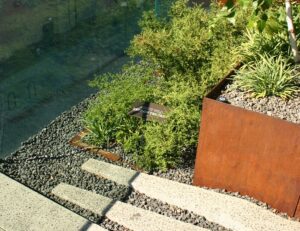By Renee Godfrey Quillin
The Garden Media Group announced that their pick for the 2023 Color of the Year is Terra Cotta. A new year gives rise to a fresh focus on the garden and no other better way to do so but with incorporating the timeless material with the warm and earthy tones of terra cotta pottery. This made me reflect on how modern design has strayed away from using terra cotta clay pots in the garden. I would like to focus on the advantages and disadvantages of terra cotta pottery and look into a more modern alternative like Cor-ten steel, emphasize on proper placement and plant design primarily to accentuate the rich red and orange hues of terra cotta pots in a modern garden.

The cheerful beauty of terra cotta clay pots does have its advantages and disadvantages. Terra cotta is derived from the Latin words terra cocta, meaning ‘cooked earth’ which is known now as ‘baked earth’. The clay used for terra cotta is combined with water are fired at a low temperature resulting in a porous and brittle earthenware. The advantage of terra cotta porosity is that it allows air to flow greatly preventing root rot and other soil disease. In the return the disadvantage is that terra cotta pots need to be watered more regularly then say ceramic pottery. Under certain environmental conditions, terra cotta cannot handle freezing temperatures, so it is advisable to clean out terra cotta pots and store in the winter months. Another advantage to terra cotta is that they are all natural, if one were to break, then simply till into the soil and give back to the earth.

Cor-ten steel is an alternative that develops a rich and warm reddish orange tone over time. When Cor-ten steel is oxidized from atmospheric exposure, it creates a highly corrosion resistant rich rust patina layer that makes the steel last a lifetime. Therefore, the advantage to Cor-ten steel is it’s longevity and is essentially maintenance free. The disadvantage is limited by environmental factors, can have an uneven color variation and the protective surface rust can leach or run off onto other surfaces. There are both advantages and disadvantages to both Cor-ten steel and terra cotta, it’s all about the design and look one is going for.

The simplicity of modern or contemporary design uses a balance of neutral tonal color such as shades of browns or grays along with black and white for contrast. Modern garden design integrates tonal colors with sharp edges of greenery with a main focal point for a harmonic flow in any outdoor living space. We can use this main architectural focal point to incorporate an eye-catching statement of a terra cotta pot that will give the tonal surroundings that earthy flare.

Mediterranean style is another garden trend that is on the rise and utilizes drought-tolerant fragrant culinary herbs such as oregano, rosemary, and thyme that will do fantastic in terra cotta pottery. Lavender or wispy grasses like Schizachyrium scoparium also give a Mediterranean vibe while complimenting the earthy warmth of terra cotta. Aged terra cotta develops a patina look of whites and green that will look more pronounced up against a dark back drop like a wooden fence.

Certain plant bloom and foliage colors along with texture design to accentuate the vibrant color of terra cotta. Opposite of terra cotta on the color spectrum are shades of blue; incorporate blue to bluish purple to a deep lavender flowering for an eye-catching contrast. The porosity of terra cotta makes them great to plant succulents, annuals and plants that don’t like ‘wet feet’. Here are some color combination examples:
Annuals such as True Blue or Beaconsfield Pansies or Viola Peach Jump-up Viola to pull out the warm tones of the terra cotta pot.
Incorporate sun loving annuals such as Salvia ‘Black and Bloom’ or Calibrachoa ‘Midnight Blue’.
Use a shallow terra cotta pot to add Sempervivum ‘Ruby Heart’ or a mat forming Sedum ‘Coral Reef’.
Make a bold statement with black by planting Coleus ‘Black Coral’ or Colocasia ‘Black Magic’ to a terra cotta pot and place against a white wall.
Finally, shades of green along with a variety of textures go well with terra cotta pottery. For a partial shade environment includes grasses like Hakonechloa macra, ferns like Athyrium niponicum var. pictum (Japanese Painted Fern), perennials like Hosta ‘Halcyon’ and Heuchera ‘Green Spice’, and trailing vines like Lysimachia nummularia (Creeping Jenny).




